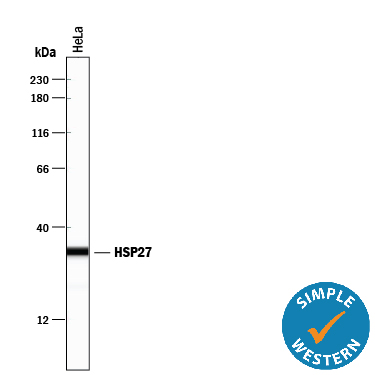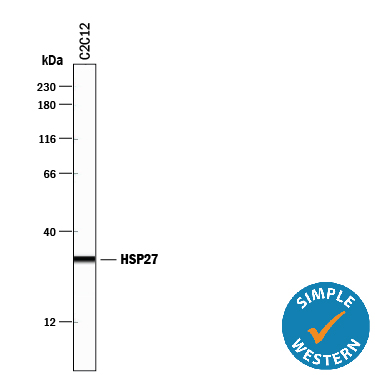Human/Mouse HSP27 Antibody Summary
Accession # P04792
Applications
Please Note: Optimal dilutions should be determined by each laboratory for each application. General Protocols are available in the Technical Information section on our website.
Scientific Data
 View Larger
View Larger
Detection of Human/Mouse HSP27 by Western Blot. Western blot shows lysates of MCF-7 human breast cancer cell line, HeLa human cervical epithelial carcinoma cell line, and C2C12 mouse myoblast cell line. PVDF membrane was probed with 0.1 µg/mL of Rabbit Anti-Human/Mouse HSP27 Antigen Affinity-purified Polyclonal Antibody (Catalog # AF1580) followed by HRP-conjugated Anti-Rabbit IgG Secondary Antibody (Catalog # HAF008). A specific band was detected for HSP27 at approximately 27 kDa (as indicated). This experiment was conducted under reducing conditions and using Immunoblot Buffer Group 2.
 View Larger
View Larger
Detection of Human HSP27 by Simple WesternTM. Simple Western lane view shows lysates of HeLa human cervical epithelial carcinoma cell line, loaded at 0.2 mg/mL. A specific band was detected for HSP27 at approximately 31 kDa (as indicated) using 0.5 µg/mL of Rabbit Anti-Human/Mouse HSP27 Antigen Affinity-purified Polyclonal Antibody (Catalog # AF1580). This experiment was conducted under reducing conditions and using the 12-230 kDa separation system.
 View Larger
View Larger
Detection of Mouse HSP27 by Simple WesternTM. Simple Western lane view shows lysates of C2C12 mouse myoblast cell line, loaded at 0.2 mg/mL. A specific band was detected for HSP27 at approximately 31 kDa (as indicated) using 0.5 µg/mL of Rabbit Anti-Human/Mouse HSP27 Antigen Affinity-purified Polyclonal Antibody (Catalog # AF1580). This experiment was conducted under reducing conditions and using the 12-230 kDa separation system.
 View Larger
View Larger
Western Blot Shows Human HSP27 Specificity by Using Knockout Cell Line. Western blot shows lysates of HeLa human cervical epithelial carcinoma parental cell line and HSP27 knockout HeLa cell line (KO). PVDF membrane was probed with 0.5 µg/mL of Rabbit Anti-Human/Mouse HSP27 Antigen Affinity-purified Polyclonal Antibody (Catalog # AF1580) followed by HRP-conjugated Anti-Rabbit IgG Secondary Antibody (Catalog # HAF008). A specific band was detected for HSP27 at approximately 27 kDa (as indicated) in the parental HeLa cell line, but is not detectable in knockout HeLa cell line. GAPDH (Catalog # MAB5718) is shown as a loading control.. This experiment was conducted under reducing conditions and using Immunoblot Buffer Group 1.
Reconstitution Calculator
Preparation and Storage
- 12 months from date of receipt, -20 to -70 °C as supplied.
- 1 month, 2 to 8 °C under sterile conditions after reconstitution.
- 6 months, -20 to -70 °C under sterile conditions after reconstitution.
Background: HSP27
Heat shock proteins (HSPs) are a family of highly conserved stress response proteins. Heat shock proteins function primarily as molecular chaperones by facilitating the folding of other cellular proteins, preventing protein aggregation or targeting improperly folded proteins to specific degradative pathways. HSPs are typically expressed at low levels under normal physiological conditions but are dramatically up-regulated in response to cellular stress. Elevated levels of HSPs have been observed in association with ischemia/reperfusion, cancer, and chronic heart failure. HSP27, also known as HSPB1, is a member of the small heat shock protein family, which also includes HSP25 and the alpha -crystallins. HSP27 forms a large oligomer and the extent of phosphorylation plays a role in determining specific functions. HSP27 also functions as an anti-apoptotic molecule, regulating apoptosis through direct interaction with key components of the apoptotic pathway. HSP27 binds and sequesters cytochrome c released from the mitochondria in response to an apoptotic stimulus. This prevents the proper assembly of the apoptosome and subsequently, the activation of procaspase-9 and procaspase-3. Full length human HSP27 shares 83% and 81% aa identity with mouse and rat HSP27, respectively.
- Gusev, N.B. et al. (2002) Biochemistry (Moscow) 67:511.
- Garrido, C. et al. (2001) Biochem. Biophys. Res. Commun. 286:433.
- Garrido, C. (2002) Cell Death Diffr. 9:483.
- Brvey, J-M. et al. (2000) Nat. Cell Biol. 2:645.
Product Datasheets
Citations for Human/Mouse HSP27 Antibody
R&D Systems personnel manually curate a database that contains references using R&D Systems products. The data collected includes not only links to publications in PubMed, but also provides information about sample types, species, and experimental conditions.
3
Citations: Showing 1 - 3
Filter your results:
Filter by:
-
Heat shock protein 27 differentiates tolerogenic macrophages that may support human breast cancer progression.
Authors: Banerjee S, Lin CF, Skinner KA, Schiffhauer LM, Peacock J, Hicks DG, Redmond EM, Morrow D, Huston A, Shayne M, Langstein HN, Miller-Graziano CL, Strickland J, O'Donoghue L, De AK
Cancer Res., 2011-01-11;71(2):318-27.
Species: Human
Sample Types: Whole Cells
Applications: Flow Cytometry -
The heat shock response and chaperones/heat shock proteins in brain tumors: surface expression, release, and possible immune consequences.
Authors: Graner MW, Cumming RI, Bigner DD
J. Neurosci., 2007-10-17;27(42):11214-27.
Species: Human
Sample Types: Cell Lysates
Applications: Western Blot -
Phosphatidylinositol 3-kinase/Akt plays a role in sphingosine 1-phosphate-stimulated HSP27 induction in osteoblasts.
Authors: Takai S, Tokuda H, Matsushima-Nishiwaki R, Hanai Y, Kato K, Kozawa O
J. Cell. Biochem., 2006-08-01;98(5):1249-56.
Species: Mouse
Sample Types: Cell Lysates
Applications: Western Blot
FAQs
No product specific FAQs exist for this product, however you may
View all Antibody FAQsReviews for Human/Mouse HSP27 Antibody
There are currently no reviews for this product. Be the first to review Human/Mouse HSP27 Antibody and earn rewards!
Have you used Human/Mouse HSP27 Antibody?
Submit a review and receive an Amazon gift card.
$25/€18/£15/$25CAN/¥75 Yuan/¥2500 Yen for a review with an image
$10/€7/£6/$10 CAD/¥70 Yuan/¥1110 Yen for a review without an image




